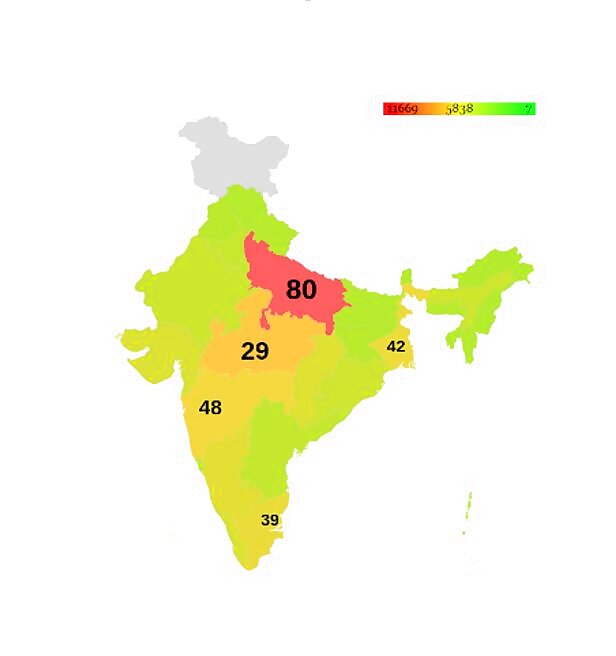
views
Since its inception in 2002, Aangan has witnessed three Lok Sabha general elections, and there is a fourth one underway. For a country as diverse as India, the elections hold varying significance and expectations for each individual and institution.
As an organisation identifying and working with lakhs of children and women struggling in unsafe environments and vulnerable communities, we see this general election as an opportunity to seek relief for our unsafe children. We hope for manifestos of political parties that emphasise empowering 14-year-old Raghav who identified that he was at the risk of getting trafficked, 12-year-old Reshma who persuaded her parents to send her to school, Aarti who resisted her marriage at the age of 14, and many other children and women who face safety challenges every day.
In this article, we review the election manifestos of the two most prominent national political parties of India: the Bharatiya Janta Party (BJP) and the Indian National Congress (INC), illuminating their attention to child protection and highlighting areas for improvement.
An election manifesto of any political party conveys what they perceive to be the needs, desires, and the grievances of their constituents. It is a platform for political parties to express their commitment to address crises that challenge society today.
Year after year, and tenure after tenure, without fail, child protection is a cause that does not recognise regional or political differences. Every state in India faces some form or the other of vulnerability for children.
With an expansive population pyramid that has its children and youth growing to lead the nation, India cannot afford to let its children remain unsafe and unprotected.
Aangan is focused on four broad issues within these manifestos: women-led development, the condition of aanganwadis, child trafficking, and impacts of internal migration on children.
We advocate for inclusive women-led development, evaluation of the conditions of anganwadis to find solutions to their ineffectiveness, a proposal for specific policies and programmes against child trafficking, and analysis of local data on internal migration and its impact on children.
Women-led Development
The BJP’s manifesto aligns with Aangan’s belief in “women-led development.” The party mentions Capacity Building for Women in their manifesto, defining it as providing education, financial assistance, and access to resources. However, based on Aangan’s direct experience over the last 17 years, India’s women need more than economic capacity building today.
For example, our women volunteers in Bihar, Uttar Pradesh, Jharkhand, Rajasthan, West Bengal, and Maharashtra report that the reason they have volunteered to become part of Aangan’s community engagement is the feeling of awareness and emancipation they derive from the work and the hope of giving their children safer and better childhood than the ones they themselves led.
It is thus imperative to continue to promote a “women-led development” programme. While economic support is an important aspect of women-led development, it is critical that the government can answer questions like:
1) Do girls/women find police stations accessible?
2) While we are talking about boosting women in the workforce, do girls of marginalised communities manage to enroll in the nearest government schools?
3) Is there a primary and secondary government school at a walkable distance for every child in the expanse of the country?
Aanganwadis
It is crucial to make women conscious of their inherent rights. The INC manifesto promises appointment of Adhikar Maitri in every Panchayat, to educate and assist women in the enforcement of their legal rights.
If implemented correctly, a platform like this, that too at the most rural institutional level, will be a milestone of women’s empowerment in India. This Party also seeks to strengthen aanganwadis by providing creches and expanding the Integrated Children Development Scheme (ICDS).
In our efforts to make children safe, our foremost steps include ensuring that primary school age children are enrolled in aanganwadis. We have observed that aanganwadis face serious functional issues.
In addition to a severe lack of infrastructure, we find that aanganwadis have staff who are hard pressed to meet the needs of administering such an institution, let alone providing basic non-formal education to children.
Aanganwadis have a poor record of regular operation, which directly affects regular immunisation and check-ups of children. In the prime cropping and harvest seasons when the childcare requirements are higher, the aanganwadis become even less functional.
The staff goes to work in the fields, rather than caring for children of parents who go to work in the fields. Given the shortcomings regarding the performance of aanganwadis, Aangan asserts the importance of a performance evaluation to find particular areas for improvement.
The BJP manifesto briefly refers to establishing inspection standards to monitor childcare institutions. Aangan believes that instituting a universal operating standard for the Aanganwadis would create a foundation from which these institutions could grow. Our field experience with children and women suggests that strengthening aanganwadis should focus on making the existing provisions efficient rather than introducing new ones.
Child Trafficking
National Crime Records Bureau, India states that a child is trafficked every eight minutes in India. From 2004 to 2014, the Bureau data illustrate a spike in the trafficking of girls under 18 years old.
In 2014 alone, trafficking rose by 6 percent. In 2016, The National Human Rights Commission discovered the trafficking of 20,000 women and children, a 25 percent increase from 2015.
The Commission highlights four of the states where child trafficking is most rampant: Bihar, Uttar Pradesh, Rajashtan and West Bengal. These are four states in which Aangan is very active for this very reason.
In the last two years, Aangan has discovered more than 300 children who were either trafficked or were at risk of trafficking in the states of Uttar Pradesh, Jharkhand, West Bengal, and Bihar.
This alarming rate of trafficking in the country grievously calls for strict policies, programmes and measures. It is devastating that neither the BJP nor the INC have found a place for this extremely important issue in either of their election manifestos.
The INC does address crime against children, and has discussed improving Child Protection Services. Again, the measures are more inclined towards infrastructural development like increasing POCSO courts, putting trials on fast track etc., which is undoubtedly important. However, problematic aspects within the implementation of child safety policies and programmes stand in need of equal attention, or example the clause on mandatory reporting for POCSO cases, high acquittal rate due to child marriages, etc.
The question we need to ask our government is: Are these issues being neglected because they require immense courage to be dealt with or because they do not hold enough importance in the electoral politics?
For a regular newspaper reader, it is no surprise to find news pieces on child abduction, trafficking, and rape every day. As aware citizens, are we choosing to ignore this critical issue while deciding our parameters for good governance? Why are we not demanding robust policies to counter child trafficking?
Internal Migration
In 2017, the World Economic Forum published a report titled “India has 139 million internal migrants. They must not be forgotten.” And indeed, they must not be forgotten when it comes to safety and protection of children.
The Economic Survey of India, 2017 estimates that nine million people migrated inter-state annually between 2011 and 2016. Uttar Pradesh and Bihar are found to be the biggest sources for migration to metropolitan and other cities and towns.
In the seven states in which Aangan works, migration (seasonal or otherwise) impacts children severely. Children are left unsupervised, they drop out of school, they are abducted, they are engaged in child labour, and they face many other threats in absence of their parents’ protection.
At the village level, government institutions need to maintain a record of these migrant families, so that effective relevant programmes could be made accessible to the children. In the cities where these migrants reside, accessing education, healthcare, and hygienic living conditions is extremely difficult for migrant children.
According to Global Education Monitoring Report (GMR), 2019, 80 percent of children of seasonal workers have never accessed education in India. The report also explains how the children of migrant workers are not considered dropouts despite huge attendance gaps.
While they promise to ameliorate unemployment, both parties have failed to address inter-state migration and its impact on child safety. Doesn’t this call for a place in the inclusive development goals of both political parties?
Conclusion
While Aangan works endlessly to make the country a safer place for our children, we are also hopeful for a government that is committed to caring for the nation’s children. As discussed, we recommend to the upcoming government, Capacity Building of women and girls so that they are capable of keeping themselves safe, qualitative evaluation of aanganwadis to figure out the right measures to make them effective, programmes to end child trafficking, and mitigating the impacts of labour migration on children.
As the world’s largest democracy enters the election season, it is imperative to self-educate and bring awareness to others about the importance of safety and education for our future generations.
MAP: State wise depiction of reporting of POCSO cases in India.
Highest to lowest from red to green.
The number of Lok Sabha seats in the top 5 states with highest reporting of POCSO cases.
*No data available for Jammu and Kashmir regarding POCSO.

(The author works in Child Protection advocacy at Aangan Trust, India. Views expressed are personal.)




















Comments
0 comment